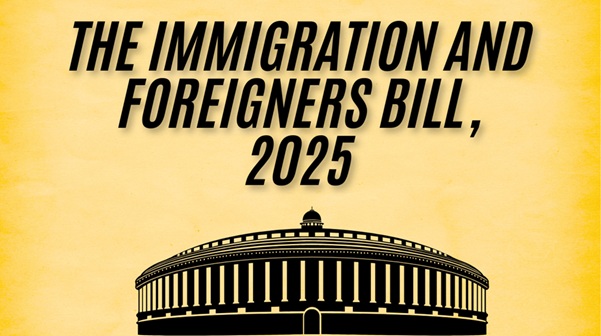(Prelims: Current Affairs)
(Mains, General Studies Paper-2: Parliament and State Legislatures- Structure, functions, conduct of business, powers and privileges and issues arising out of them.) |
Context
The ‘Foreigners and Immigration Act, 2025’ passed by the Parliament has come into force from 1 September 2025, which has integrated all the scattered laws related to immigration.

About the new Foreigners Act
- Name of the Act: The Immigration and Foreigners Act, 2025
- Date of coming into force: From 1 September 2025
- Objective: To streamline the entry, stay, movement and exit of foreign nationals and create a digital and centralised monitoring system.
- Passed in Parliament
- Lok Sabha: Passed on 27 March 2025
- Rajya Sabha: Passed on 2 April 2025
- Presidential assent: 4 April 2025
- This Act repealed the following old laws:
- The Passport (Entry into India) Act, 1920
- The Registration of Foreigners Act, 1939
- The Foreigners Act, 1946
- The Immigration (Carriers’ Liability) Act, 2000
Key provisions
- Valid documents required: Passport and visa mandatory (except for certain categories).
- Entry and exit: Only through government-notified airports, sea ports, rail and land border posts.
- Powers of immigration officers: Final decision on entry/exit, power to bar entry on national security grounds.
- Registration system: Registration of foreign nationals through local SP/DCP or FRRO (Foreigners Regional Registration Office).
- Responsibility of accommodation provider: Hotels, hostels, religious institutions etc. must send information of foreign nationals online within 24 hours.
- Educational and medical reporting: Universities and hospitals must report admissions, births and deaths.
- Restricted area permission: Special permit required to visit restricted/protected areas.
- Digital records: Available on all information portals and mobile apps.
- Fines and penalties: Fines ranging from Rs 10,000 to Rs 5 lakh for violations; as low as Rs 50 for certain communities.
- Appeal system: Scope for appeal and exemption on humanitarian grounds.
Exempted categories
- Indian military personnel and their families (by government transport).
- Nationals of Nepal and Bhutan (entering through special routes).
- Tibetan refugees (on approved entry from 1959 to 2003 or later).
- Minority refugees from Afghanistan, Pakistan, Bangladesh (Hindus, Sikhs, Buddhists, Jains, Parsis, Christians entering up to 31 December 2024).
- Registered Sri Lankan Tamil refugees (up to 9 January 2015).
- Diplomatic passport holders of certain countries.
- Foreign military personnel coming for humanitarian or military exercises.
Why a new Act was needed
- The old laws were fragmentary and vague.
- Migrant data collection was manual, creating security risks and information gaps.
- There was confusion about authority between local and central authorities.
- There were unclear provisions for refugees and groups from neighbouring countries.
Importance
- Integration of all laws: transparency and simplicity.
- Digital reporting: faster and accurate monitoring.
- National security: better control.
- Reduced burden on courts: quick resolution through fines and compounding.
Concerns
- Excessive centralisation: Limited role of states.
- Administration: Additional administrative burden on hotels, universities, hospitals.
- Citizenship: Ambiguity regarding citizenship may persist for refugees and minorities.
- Privacy: Concerns about data security.
Way Forward
- Ensuring better coordination between states and the Centre.
- Clear long-term policy for refugees and asylum seekers.
- Strengthening data protection and privacy provisions.
- Making appeals and exemptions on humanitarian grounds more transparent.
- Simplification of visa and immigration processes in line with international standards.



